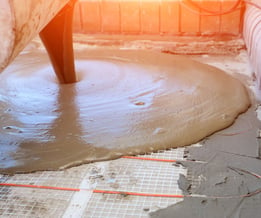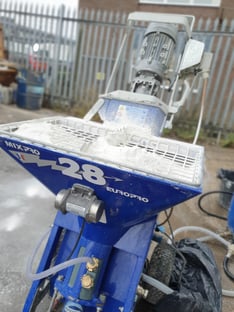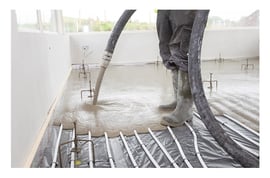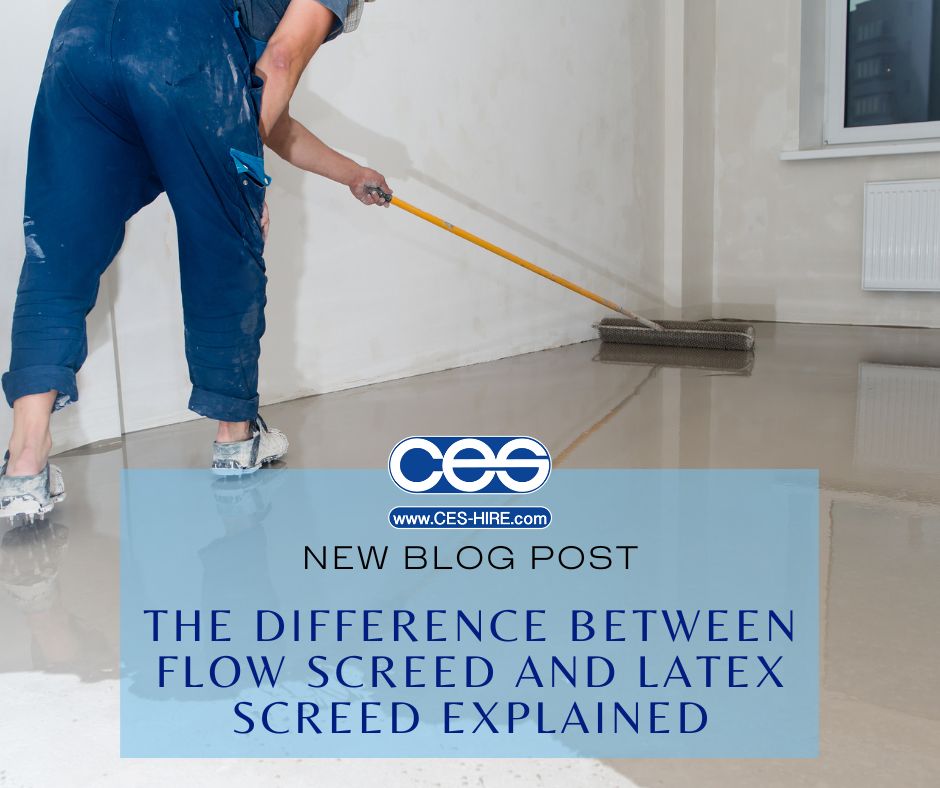Flow Screed and latex screed are both highly sought-after materials in the flooring domain having become a popular alternative to traditional sand and cement screed. You may have heard of flow screed being referred to as liquid, pumpable or self-levelling screed. Latex screed can also be referred to as self-levelling or self-smoothing compound so it can get confusing as to which is which. This blog should help you understand the differences between the two flooring materials.
How are Flow and Latex Screed Similar?
Flow and Latex screed are very similar in their pourable, self-levelling nature. They can be poured or pumped and, due to their liquid consistency, they will spread to fill the space and create a level flooring surface. They require very little finishing as they self-smooth and level out themself. The pourable qualities mean that liquid and latex screed are less labour intensive and able to be easily applied with a much smaller team. They are a robust and durable coating for the substrate beneath which subsequently allows a decorative flooring finish to be added (carpet, ceramic tiles, vinyl, wood, laminate etc). These modern screeds are applied a lot more thinly than traditional sand and cement screed and the lightweight spread means very quick curing times allowing a much faster turn around on a property. Both materials work well with underfloor heating since the liquid encases the pipes perfectly allowing effective heat transfer and energy efficiency.
So What are the Differences?

Whilst flow and latex screed are fairly alike as a versatile flooring layer which can adapt to a variety of spaces, there are some significant differences with these types of screed.
The main difference is how the two materials are supplied and therefore the projects they are most appropriate for..
Self Levelling & Latex Screeds
 Latex screed such as Setcrete is supplied in bags and is self-mixed by adding water. This can then be mixed using a paddle/power mixer or a machine such as the Euromair MixPro 28. Pre-bagged self-levelling compounds such as Setcrete or Weber Fibre 4310 are great for smaller residential, commercial projects or renovations with light-medium traffic. It is important to remember not to mix more material than you can pour in 15minutes since latex screeds cure exceptionally quickly, again a reason they may not be suggested for large projects. Latex screeds can be laid as thinly as 2mm; a product such as Setcrete advises laying 2-10mm. This thin layer also means incredibly quick drying times; it can be ready for light foot traffic between 2-4 hours and floor covering can be installed as little as 24 hours later (this is all of course dependent on weather conditions and depth laid).
Latex screed such as Setcrete is supplied in bags and is self-mixed by adding water. This can then be mixed using a paddle/power mixer or a machine such as the Euromair MixPro 28. Pre-bagged self-levelling compounds such as Setcrete or Weber Fibre 4310 are great for smaller residential, commercial projects or renovations with light-medium traffic. It is important to remember not to mix more material than you can pour in 15minutes since latex screeds cure exceptionally quickly, again a reason they may not be suggested for large projects. Latex screeds can be laid as thinly as 2mm; a product such as Setcrete advises laying 2-10mm. This thin layer also means incredibly quick drying times; it can be ready for light foot traffic between 2-4 hours and floor covering can be installed as little as 24 hours later (this is all of course dependent on weather conditions and depth laid).
Liquid Screed
 Liquid Screed is either a cement-based compound or anhydrite (gypsum based). Liquid or flow screed, unlike latex screed, comes in a ready mix truck so is generally suited to much larger projects and/or deeper fills. Whilst it is still poured at a shallower depth than traditional sand and cement screed, the minimum 35mm pour is certainly deeper than 2-10mm latex screed layer. Brands such as Cemfloor are popular as a cement-based free-flowing liquid screed and will pump up to 2000m² per day, hence the suggestion that this is suitable for larger scale jobs. Liquid screed also benefits from speedier curing times than traditional screed with foot traffic allowed after 24-48 hours and flooring can be laid 7-14 days later. We would recommend machine-applying your flow screed, find out more about the benefits of using a screed pump here >. The Euromiar MixPro 50 would be a great option of screed pump for larger jobs using liquid screed.
Liquid Screed is either a cement-based compound or anhydrite (gypsum based). Liquid or flow screed, unlike latex screed, comes in a ready mix truck so is generally suited to much larger projects and/or deeper fills. Whilst it is still poured at a shallower depth than traditional sand and cement screed, the minimum 35mm pour is certainly deeper than 2-10mm latex screed layer. Brands such as Cemfloor are popular as a cement-based free-flowing liquid screed and will pump up to 2000m² per day, hence the suggestion that this is suitable for larger scale jobs. Liquid screed also benefits from speedier curing times than traditional screed with foot traffic allowed after 24-48 hours and flooring can be laid 7-14 days later. We would recommend machine-applying your flow screed, find out more about the benefits of using a screed pump here >. The Euromiar MixPro 50 would be a great option of screed pump for larger jobs using liquid screed.
Weigh-up your options
So in a nutshell, both screeds offer a liquid-based, quick-to-apply solution for flooring that will self-level to achieve a supremely flat, even subfloor for your floor finishing. They are ideal modern methods of working that cope with the time pressures of projects since they both offer quick curing times so a job can be completely finished in a fraction of the time compared to traditional screed. Find out more about how to achieve the best results with floor screed here > It is worth considering the size of your project and the current flooring conditions when you weigh up the type of screed to choose. Don’t forget to give CES a call if you choose to machine-apply your screed and we can offer you options for the best machine for you.



